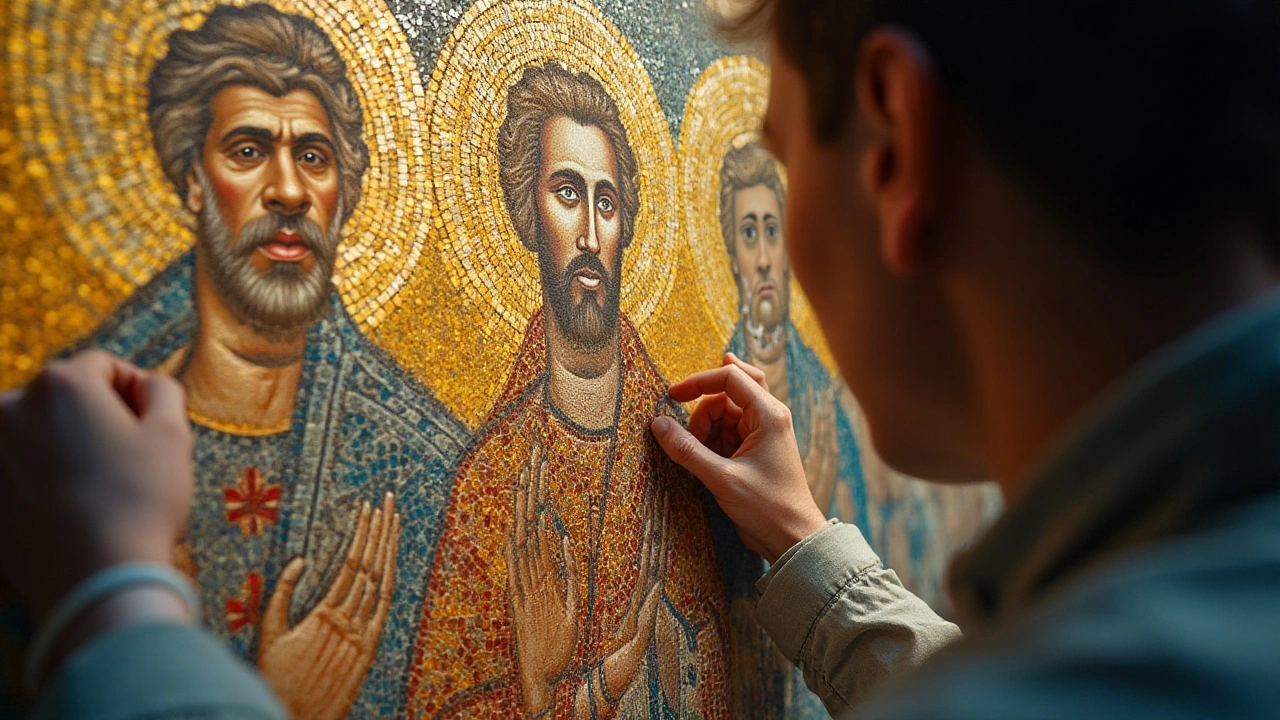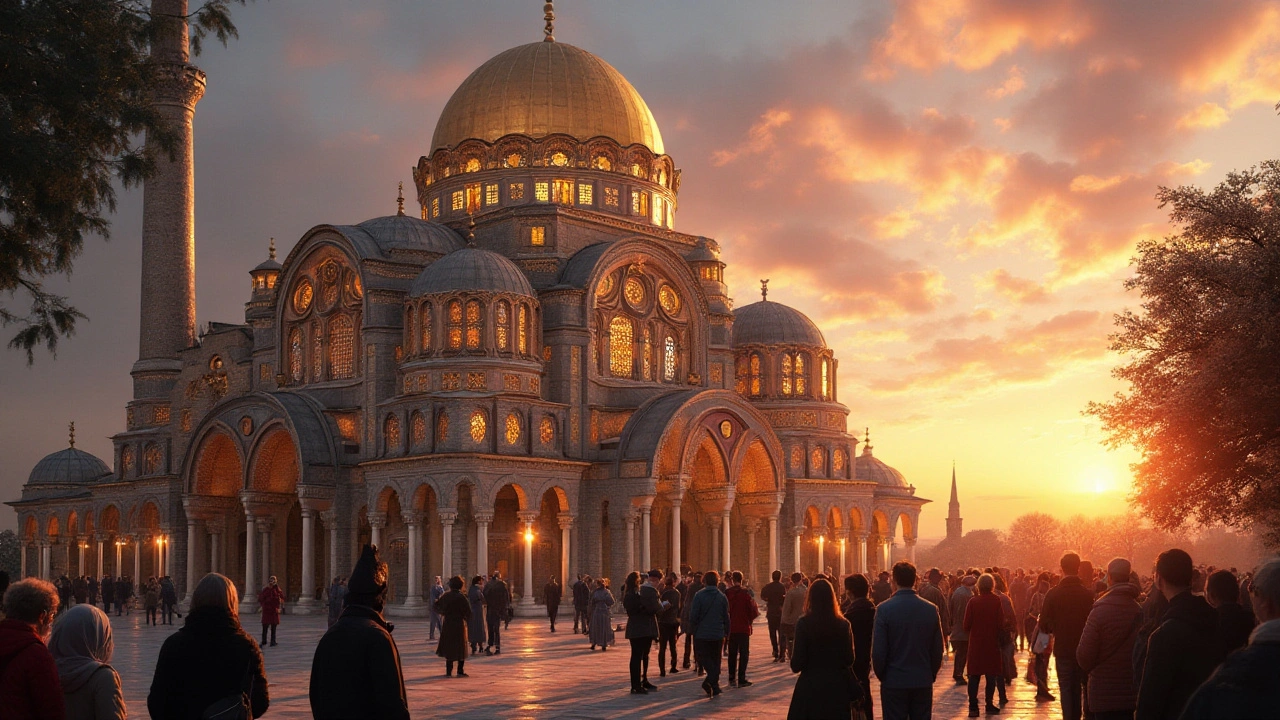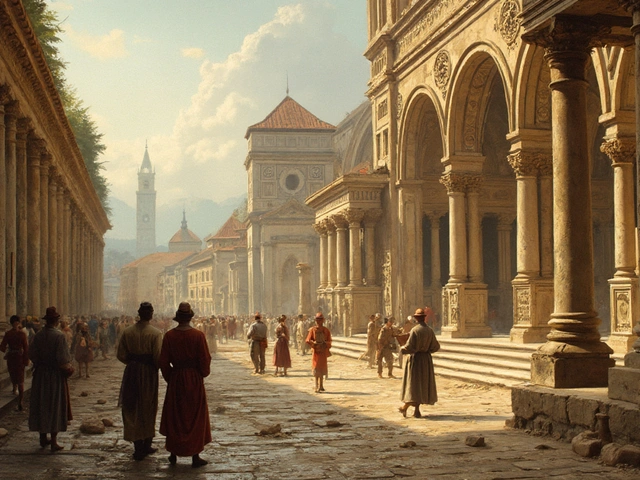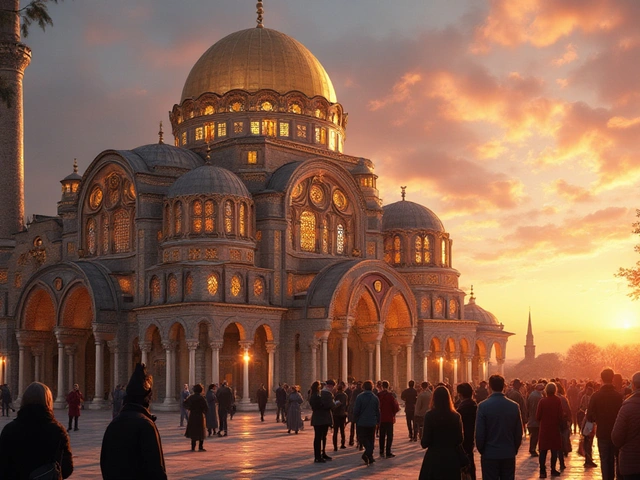The Byzantine era, spanning from the 4th century until the fall of Constantinople in 1453, marked a period of remarkable architectural innovation. Combining Roman engineering prowess with Eastern artistic flourishes, Byzantine architecture has left an indelible mark on history.
In this golden era, architects and craftsmen achieved what others had only dreamt—creating imposing structures that were not only awe-inspiring but also served as symbols of the Christian faith. Think of the majestic Hagia Sophia in Istanbul, a masterpiece that reflects both divine and earthly grandeur. The practice of using extensive mosaics, elaborate domes, and new methods for distributing weight in large constructions became benchmarks that guided future architectural endeavors.
The legacy of Byzantine architecture is vast and varied, with each structure offering a glimpse into the ingenuity and artistry of the era. Understanding its key features and influences helps us appreciate the grandeur and intricacy of designs meant to transcend generations. Whether standing beneath the opulence of a massive dome or tracing the delicate lines of a centuries-old mosaic, one is reminded of a time when architecture was a testament to human ingenuity and spiritual devotion.
- Origins and Influences
- Key Architectural Features
- Iconic Structures
- Symbolism in Design
- Legacy and Impact
Origins and Influences
Byzantine architecture, a hallmark of historical and architectural significance, drew its roots from the time of Emperor Constantine the Great. When Constantine moved the capital of the Roman Empire to Byzantium in 330 AD, he renamed it Constantinople, laying the foundation for what would become an epicenter of innovation and cultural amalgamation. This fusion of the East and West gave birth to a distinctive style that has enthralled scholars and enthusiasts alike for centuries.
One of the key influences on Byzantine architecture was Roman engineering. The Romans were adept at creating durable structures, which they achieved through advanced techniques like the use of concrete and the arch. These methods were adopted and adapted by Byzantine architects, who combined them with Greek aesthetics and elements from the Near East. The result was a unique synthesis that stood the test of time in form and function.
Religious significance also played a pivotal role. The shift from paganism to Christianity brought about a change in architectural priorities. Churches became central to societal life, necessitating spaces that could inspire awe and devotion. This led to the construction of grand basilicas and intricate mosaics, both of which became characteristic features of Byzantine architecture. The emphasis on spiritualism and divine connection can be seen in the designs that focus on upward, heaven-reaching forms and extensive use of light to symbolize the divine.
One cannot discuss Byzantine architecture without mentioning its major patrons. Emperors and religious leaders were instrumental in commissioning works that signified their piety and power. For instance, Emperor Justinian I, whose reign from 527 to 565 AD is often referred to as the Byzantine Empire's golden age, commissioned the Hagia Sophia, a marvel of engineering and artistic sophistication. This building, with its imposing dome and expansive use of mosaics, set a standard for architectural excellence.
According to historian Procopius, the Hagia Sophia was "a colossal work that seemed to be suspended from heaven by that golden chain, and the central church gleamed daily with fresh beauty."
Cultural exchanges through trade and conquest also had a considerable impact. As the Byzantine Empire expanded, incorporating diverse regions, it absorbed various architectural styles and techniques. This eclectic approach resulted in a rich and varied architectural landscape, from the bustling metropolitan areas to the quieter, provincial settings. Byzantine architecture thus became a melting pot of influences, from Persian to Slavic, all woven into a cohesive yet complex tapestry.
The social and political stability provided by the Byzantine Empire also contributed to architectural innovation. With a strong central authority and a well-organized bureaucracy, resources could be concentrated on monumental building projects. This economic prosperity and administrative efficiency afforded architects the luxury of time and material resources to experiment and refine their techniques.
Geographical advantages gave Byzantine architects access to high-quality materials like marble from the quarries of Proconnesus and bricks from the rich clay deposits around the Black Sea. The strategic location of Constantinople also facilitated trade with other civilizations, bringing in not just materials but also ideas and skilled artisans from different parts of the world. The abundance of resources and the influx of diverse influences resulted in a style that was both distinct and innovative.
Key Architectural Features
The grandeur of Byzantine architecture lies in its ability to merge functional ingenuity with aesthetic beauty. At its core are several defining elements that together create an unmistakable style recognized through the ages.
First and foremost are the elaborate domes, which not only captivate one's gaze but also showcase the era's advanced engineering techniques. The most famous of these is the dome of the Hagia Sophia, an engineering marvel of its time. Its massive size is made possible by pendentives—triangular sections of a sphere that transition the weight from the dome to the supporting pillars below. The effect of this is a sense of weightlessness and divine space that leaves visitors in awe of its design.
Another hallmark is the extensive use of mosaics. Crafted from small pieces of glass, stone, or ceramic, these mosaics depict both sacred and secular themes with incredible detail and vivid colors. Each mosaic tells a story, often illuminating the grandeur of the Byzantine court or the divine nature of Christ and the saints. Walking into a Byzantine church, one is immediately struck by the lush, sparkling imagery covering the walls and ceilings, reflecting light in a dance of colors. It was said by Procopius, the court historian of the Emperor Justinian, that the mosaics “shone with a light that seemed to come from the ever-radiant sky.”
Structural innovation did not stop at domes and mosaics. The floor plans of Byzantine buildings were carefully designed to enhance their function and aesthetic appeal. The central-plan building, often in the shape of a Greek cross, became a prominent layout. This design not only facilitated congregational activities but also symbolized the holy cross, reinforcing the divine purpose of the space. The layout allowed for a large central dome supported by smaller semi-domes, creating a harmonious balance and intricate internal geometry.
One cannot ignore the elaborate use of columns and capitals. While the Romans had perfected the use of columns, the Byzantines took it a step further by adding intricate carvings and symbolic decorations. Columns often featured detailed, intricate carvings of acanthus leaves, geometric patterns, and Christian iconography. These were not just decorative elements but also held symbolic meanings, intertwining the realms of artistic beauty and spiritual symbolism.
Light also plays a crucial role in Byzantine architectural design. Architects employed strategically placed windows, often filled with translucent marble or stained glass, to control how light entered and illuminated the space. This not only added to the aesthetic and ethereal quality of the interiors but also symbolized divine light, creating a sense of otherworldly presence. The use of light is particularly evident in the Hagia Sophia, where a ring of windows at the base of the dome causes the dome to appear as if it is floating on a halo of light.
During its zenith, Byzantine architecture was not confined solely to churches and cathedrals. Palaces, public buildings, and even city walls exhibited the same level of artistic and structural sophistication. For example, the Great Palace of Constantinople was a sprawling complex adorned with exquisite mosaics and extensive gardens, reflecting both the imperial power and aesthetic sensibilities of the era.
The influences of Byzantine architecture spread far beyond the empire's borders. Its elements can be seen in the architecture of Eastern Orthodox churches in Greece, Russia, and the Balkans, as well as in Islamic architecture after the fall of Constantinople.
All of these features together form the tapestry of Byzantine architecture, reflecting a civilization that valued both technical innovation and artistic beauty, creating spaces that have inspired awe and reverence through the centuries.
Iconic Structures
When discussing Byzantine architecture, certain structures invariably come to the forefront due to their grandeur and historical significance. One such example is the magnificent Hagia Sophia, located in modern-day Istanbul. Originally constructed as a cathedral in 537 AD under the direction of Emperor Justinian I, the Hagia Sophia epitomizes the ingenuity and artistry of the Byzantine era. Its vast dome, which seems to float miraculously above the central nave, was a marvel of engineering for its time and influenced architectural design for centuries to come.
The Hagia Sophia is not just a work of construction; it's a symbol of the empire's might and faith. For nearly a thousand years, it held the title of the world's largest cathedral and remains one of the best-preserved examples of Byzantine architecture. The interior is adorned with intricate mosaics, marble pillars, and a sense of divine light, achieved through strategically placed windows. According to the historian Procopius, Emperor Justinian exclaimed upon the completion of the Hagia Sophia, "Solomon, I have outdone thee!" Such statements underline the monumental nature of this edifice and its intended splendor.
Another iconic structure is the Church of San Vitale in Ravenna, Italy. Constructed under the reign of Justinian I, this church is renowned for its stunning mosaics that depict biblical scenes amid elaborate decorative patterns. The octagonal structure is a testament to the architectural experimentation that characterized the Byzantine era. San Vitale showcases a unique blend of Roman and Byzantine elements, particularly visible in its use of space and decoration. The church’s mosaics, especially the famous depiction of Emperor Justinian and Empress Theodora, speak volumes about the religious and political narratives of the time.
Moving to the Eastern Mediterranean, the Monastery of Hosios Loukas in Greece is another exemplary Byzantine structure. Built during the 10th century, this monastery features a domed cross-in-square plan, typical of middle Byzantine religious buildings. Its brickwork patterns, known as cloisonné, and decorative use of marble and mosaic art make it a visual feast. The interior houses some of the era's most exquisite mosaics, often depicting Christ Pantocrator, Virgin Mary, and various saints. Each piece is meticulously crafted to convey deep religious meaning and maintain an aura of sacredness.
The Church of the Holy Apostles in Thessaloniki, Greece, also deserves mention. Constructed in the late 14th century, it is one of the last great constructions of the Byzantine Empire before its decline. This church is a hidden treasure trove of Byzantine art, featuring an array of mosaics and frescos that capture the spiritual focus of its creators. Its complex layout, with a central dome and surrounding chapels, reflects Byzantine innovations in structure and design. While less known than Hagia Sophia, it offers invaluable insights into the architectural developments of the Byzantine period's twilight years.
These structures represent more than just religious significance; they are monuments to the artisans' skill and the Empire’s ambition. When visiting these sites, one is not only overwhelmed by their scale and beauty but also by the palpable history embedded within their walls. As tourism to these historic sites continues to grow, they offer an enduring connection to a time when architecture was as much about faith as it was about form. Their enduring legacy cements the Byzantine era's influence on modern architectural practices, making a study of these monuments both fascinating and essential.
Symbolism in Design
The world of Byzantine architecture is richly embroidered with symbolism, each element carefully chosen to convey deeper meanings tied to spirituality, theology, and cosmology. This era's structures are not mere buildings; they are visual narratives that transcend time and continue to inspire awe and reverence.
One of the most distinctive features is the use of domes, which in Byzantine thought, represented the heavens. The Hagia Sophia, with its awe-inspiring dome seemingly floating above, serves as a testament to this celestial symbolism. The light penetrating through its windows creates an ethereal atmosphere, suggesting the divine light of God. This effect was purposefully designed to elevate the mind and spirit of the worshippers, making them feel closer to the divine presence.
The Importance of Mosaics
Mosaics adorned many Byzantine buildings, each tiny piece of glass or stone contributing to a larger picture, often depicting religious scenes. These mosaics were not just art; they were visual sermons. The use of gold in these mosaics wasn't merely for opulence; it symbolized the divine light and glory of heaven. The shimmering effect created an otherworldly glow, reinforcing the sacred atmosphere of the space. An interesting example is the mosaic of Christ Pantocrator in the Hagia Sophia, which stands as an iconic representation of Byzantine art and its symbolic message of Christ’s omnipotence.
"The spiritual significance of Byzantine mosaics lies in their depiction of divine reality. They are not meant to be realistic but transcendental." - Helen C. Evans, curator of Byzantine art at The Metropolitan Museum of Art.
Architectural Plans and Layouts
The layout of Byzantine churches also embodied symbolic meanings. The central plan, often in the shape of a Greek cross, was meticulously designed to embody theological principles. The cross itself is a powerful Christian symbol, representing the crucifixion and the intersection between heaven and earth. The nave, which runs lengthwise, symbolizes the earthly realm, while the dome above represents the heavenly realm. This architectural arrangement was an attempt to create a microcosm of the universe and an ordered manifestation of the cosmos.
Even the choice of materials was symbolic. Marble, for example, was chosen for its durability and beauty, symbolizing eternity and the unchanging nature of the divine. The intricate carvings and the use of columns were inspired by ancient Roman architecture but repurposed to fit Christian ideology, demonstrating a cultural and theological continuity and transformation.
Use of Light and Color
Light played a crucial role in Byzantine architecture, acting as a metaphor for divine presence. The clever use of natural light to illuminate interiors, especially at key moments such as sunrise or during special religious ceremonies, was meant to reinforce the spiritual experience. Color, too, held special significance. Blue, often seen in the mosaics, symbolized the heavens and the infinite, while red represented the earthly world and human life. These color choices weren’t random but deliberately chosen to evoke specific emotional and spiritual responses.
By understanding the symbolic language of Byzantine architecture, one gains a deeper appreciation for its intricate designs and meaningful artistry. It's not just about the physical grandeur but the profound messages woven into every stone, every mosaic, and every architectural element. Byzantine architecture stands as a monumental testament to human creativity and its quest to bridge the mortal and the divine. Duplication and adaptation across different cultures underline its timeless appeal, reinforcing the *legacies* of these grand structures designed to tell stories of faith, power, and the cosmos.

Legacy and Impact
The enduring impact of Byzantine architecture stretches across centuries, influencing many cultures and regions. This architectural style wasn’t merely confined to the Byzantine Empire; it permeated western Europe, the Middle East, and even parts of Russia. The great domes, extensive use of mosaics, and elaborate frescoes became trademarks that others sought to emulate. The architectural principles established during this time set the stage for later gothic and renaissance styles. One can see the unmistakable influence of Byzantine elements in structures such as St. Mark's Basilica in Venice.
One of the most significant contributions of Byzantine era architects was the innovative use of the pendentive to support large domes. This breakthrough allowed for the construction of expansive, open interior spaces that were previously impossible. For example, the Hagia Sophia's massive dome, which seems to float miraculously in space, became an archetype for subsequent structures designed well beyond its own era and geographical borders.
The dissemination of Byzantine architectural styles also coincided with the spread of Orthodox Christianity. As the Eastern Orthodox Church expanded, its architectural styles followed. Russian architecture, particularly in Moscow and Kiev, shows clear Byzantine influences. The onion domes that are so characteristic of Russian churches owe their origins to the domes of Byzantine design.
Another aspect of the Byzantine architectural legacy is its role in preserving and advancing classical architecture. Though the Western Roman Empire fell, the Eastern Empire continued to build and innovate, maintaining traits of classical traditions while imbuing them with new religious and cultural values. This continuity allowed for a smoother transition to the Renaissance, which saw the revival of these classical principles in Western Europe.
“The Byzantine Empire may have dwindled, but its architecture remains a towering legacy, visible in Europe's cathedrals and within the Eastern Orthodox Church,” noted G.W. Bowersock, a noted historian.
The Byzantine influence also extends into modern architecture. Contemporary architects often draw inspiration from Byzantine design elements to instill a sense of grandeur and timelessness. Whether through the use of grand domes or intricate mosaic work, the principles developed during the Byzantine era continue to inspire and inform architectural practice today.
The legacy of Byzantine architecture is also academic. Schools of architecture around the globe study Byzantine methods to understand their technical innovations and aesthetic contributions. These studies often reveal more about the culture that created such masterpieces, deepening our understanding of human history and creativity.
So, the influence of Byzantine architecture reverberates through time, providing a bridge between the ancient and modern worlds. It serves as a testament to the ingenuity and vision of its creators, leaving an enduring impact that continues to shape our built environment today.




